Man has cut trees to produce lumber ever since tools were developed that allowed him to accomplish that task. The chain saw as a tool is a very recent development, appearing in the 1930's.
The first gasoline engine Chain Saw built in British Columbia was the TIMBERHOG. It was a copy of the Stihl model BD. The TIMBERHOG was big and heavy by todays standards. It was advertised as 8 H.P.
In the late 1930's the Stihl saws were being sold in Canada by the D.J. Smith Equipment Company of Vancouver and quite a few were in use in the woods of B.C. when the Second World War suddenly cut off the supply. Smith started by manufacturing parts to repair the Stihl units
and this led to more work being done on a complete unit which emerged as the TIMBERHOG. It was not a simple task to build this machine in Vancouver when we consider what was required but it was done and quite successfully too.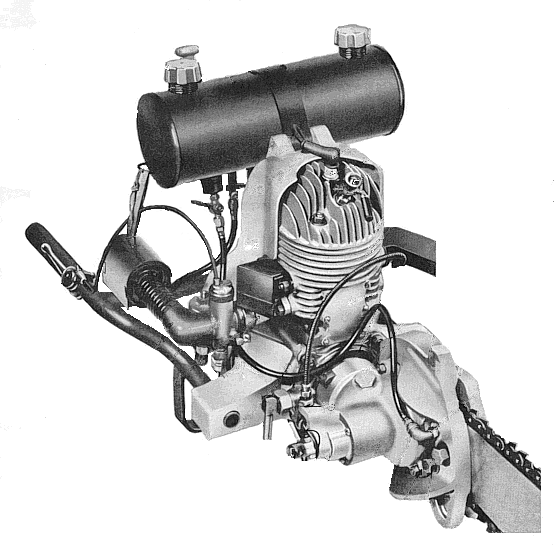
The actual weight of the powerhead without bar and chain is 96 Lbs. (43.5kg) and when equipped with a 48 inch (122cm) bar, chain, gas and oil it went up to 140 Lbs. (63.5kg). We shake our heads and comment that the men of the day must have been crazy to lug such a monster around in the woods. However when we consider that the alternative was to spend the day pulling on the end of a two man crossuct saw possibly the TIMBERHOG improved the
situation. Note the "bucker" with crosscut saw over his shoulder in the photo below.
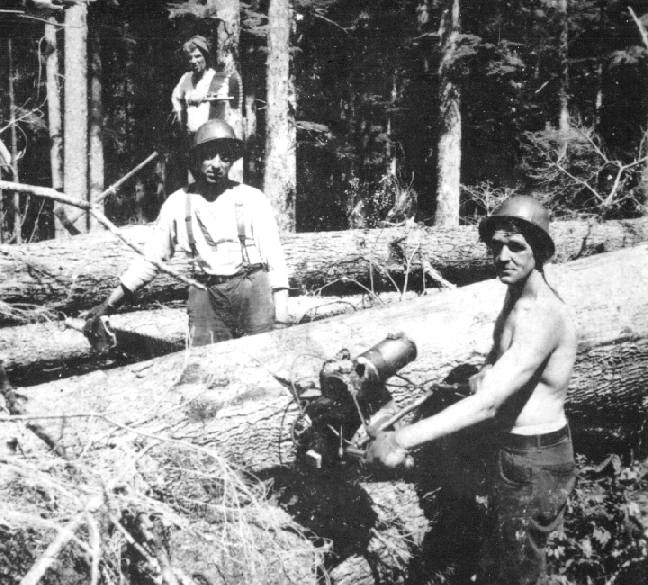
The machine operator in this picture is Mr. A.J. (Tony) Hornby of Nanaimo, B.C.
The technology in Vancouver was such that lighter weight was not possible when we consider that the aluminum had to be poured in sand cast molds and with an engine of 250cc (15.25 cu. in.) the crank-shaft, connecting rod and bearings were going to be heavy. There had to be a gear reduction transmission and mechanical clutch, all made out of either steel or brass parts. A large slide-valve float type carburetor was mounted, made out of aluminum and brass parts with an elbow and flexible hose leading to an air filter suspended with a leather strap. The ignition system was manufactured by Bendix-Scintilla mounted under the fan/flywheel. The instruction manual supplied with the saw outlined the following procedure for setting
the breaker points "when the points are wide apart, set wherever best performance is obtained between 0.012 and 0.020 in. (0.30 and 0.51mm)". In other words the operator had to do some experimenting to find the best setting for his machine. Obviously people with mechanical aptitude made much better chain saw operators which is still true today but not quite as critical as it was then. The TIMBERHOG had service requirements that were a bit more extensive than today's machines and if they were not carried out the result would be stoppage. Consider oil. The instructions supplied with the TIMBERHOG stipulated S.A.E. 50 or 60 best grade of oil mixed with 8 parts of gasoline/petrol for engine break in period and gradually increasing to a ratio of 1 to 12. The oil companies of the day had not yet developed any two-cycle oil specifically for chain saws so the only way to ensure adequate engine lubrication was to use the high S.A.E.
grade and mix it very rich. The down side of this was lots of carbon build up in the exhaust ports, on the piston and certainly on the spark plug. Today the specially formulated chain saw motor oils are virtually carbon free in comparison, stay suspended in the mixture and are used at ratio's of from 1 to 32 up to 1 to 50 depending on the make an model of the saw.
The engine that ended up powering early chain saws grew out of developments by European motorcycle manufacturers where two-cycle designs had proven successful. The TIMBERHOG had a piston ported engine as do most of todays professional chain saws. The cylinder was aluminum with a cast-iron liner. The piston was also aluminum with the dome characteristic of the loop scavenged engine.
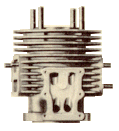  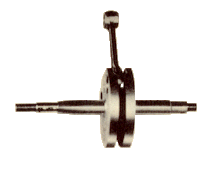
The crankshaft was full circle type, machined with a closed-eye drop forged connecting rod. The assembly ran on ball bearings with roller bearings at both ends of the connecting rod. The maximum RPM the engine would reach was about 5,000 but it would cut under load at more like 4,000. Exceeding 5,000 RPM was certain to be destructive. A 17 tooth pinion gear was mounted on the end of the crankshaft. This drove a 40 tooth bevel gear at 90 degrees and provided the change of angle and reduction all at the same time. The transmission was mounted so as to swivel and this provided the ability to fell trees or buck logs with the engine remaining in an upright position that was demanded by the float carburetor.
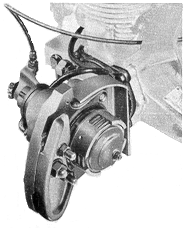 The clutch consisted of a series of metal and fiber-coated metal plates, half of which engaged the driving shaft from the transmission and half of which engaged the sprocket housing. A lever on the left handlebar was connected by a bowden cable to a mechanism on the transmission that controlled the tension of a heavy spring in the clutch with a lock for the "out of gear" position. Adjustment of clutch tension was important and was a matter of a "lock nut" arrangement on the end of the sprocket shaft as can be seen in the above picture. Incorrect adjustment would either allow the chain to move with the clutch in the dis-engaged position, or cause slipping when under load. The machine operator had to be adept at co-ordinating the operation of the clutch control lever and the throttle setting. The first The clutch consisted of a series of metal and fiber-coated metal plates, half of which engaged the driving shaft from the transmission and half of which engaged the sprocket housing. A lever on the left handlebar was connected by a bowden cable to a mechanism on the transmission that controlled the tension of a heavy spring in the clutch with a lock for the "out of gear" position. Adjustment of clutch tension was important and was a matter of a "lock nut" arrangement on the end of the sprocket shaft as can be seen in the above picture. Incorrect adjustment would either allow the chain to move with the clutch in the dis-engaged position, or cause slipping when under load. The machine operator had to be adept at co-ordinating the operation of the clutch control lever and the throttle setting. The first
machines had a throttle lever that remained whererever it was set. Eventually a spring loaded design appeared that returned the engine to idle speed when the lever was released as on a modern chain saw.
The TIMBERHOG was designed for operation by two men. There was no assist handle on the transmission that would allow the machine operator to manipulate the unit on his own. To change from felling to bucking the machine operator released the transmission locking lever and the head faller turned the bar and transmission 90 degrees. The machine operator then locked the transmission in that position. The chain ran on an idler roller that was located inside the helper handle on the outer end of the guide bar. At that time there were no "one man" bars with rounded outer end.
The machine operator had a lot more to deal with than on a modern chain saw. Consider the starting procedure. The steps outlined in the instruction manual were: 1. Set throttle lever half open. 2. Prime carburetor by pressing down primer pin on bowl of carburetor. 3. Wrap starting rope around pulley - turn motor back against compression and give a sharp, quick pull. If all went well the motor would fire and start. If not then it might require a little more priming or maybe it was over primed and much pulling would be required to clear it of excess fuel. It really flooded a plug at the base of the crankcase could be removed to drain the excess. Maybe the spark plug would be fouled and had to be removed for cleaning. Water in the fuel was as much a problem then as it is today, especially in some areas of the British Columbia coast where rain is a daily occurance. Filtering the fuel through an old felt hat would make sure no water went
into the fuel tank. Tinkering with the settings of the carburetor was not possible as the first designs had fixed jets.
Despite the draw backs the TIMBERHOG was a success and many were sold. Consider that each machine was assembled and fitted by a skilled mechanic "one at a time" For the factory of the day building 30 machines per month was quite an accomplishment. Consider also that there was a World War going on and shortages of basic materials was a daily problem. To some people the manufacturing of Chain Saws in Vancouver was a bold undertaking. Traditional bases of manufacturing were located far away in Eastern Canada and the U.S. Financing was not easy to arrange. However the trees were in British Columbia and the shortage of manpower in the woods was getting worse and that is what spurred the builders of the TIMBERHOG to persist.
Author: Mike Acres |